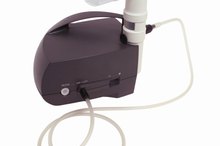Oscillator Vs. Ventilator
Hospital and home health-care equipment can appear intimidating, particularly if you aren’t sure of the machine’s purpose. Ventilators and oscillators are both used to assist patients with their breathing, and are often used in intensive care. The differences between ventilators and oscillators are few, as an oscillator is actually a type of ventilator.
Purpose
The purpose of oscillators and ventilators are to get oxygen into a patient’s lungs and remove toxic carbon dioxide from their body. According to the National Heart Lung and Blood Institute, all types of ventilators are normally found in hospitals 2.
Differences
What Is the Difference Between a Vaporizer and a Nebulizer?
Learn More
Oscillators are actually “high frequency oscillatory ventilators,” according to Neonatology on the Web, and are a relatively new type of ventilator invented in the 1990s. While a traditional ventilator physically inflates and deflates the patient’s lungs, the oscillator actually keeps lungs permanently open with a positive end-expiratory pressure, and by vibrating the air at a high rate, helping to diffuse gases.
Preferences
Oscillators are preferable when patients have particularly delicate lung structures, such as newborns and patients with lung disease like Acute Respiratory Distress Syndrome (Amanda Alves, Hospital Garcia de Orta). However, Neonatology notes that they are not necessarily appropriate for all situations; patients with other disorders may be better off with a regular ventilator.
Duration
Differences Between Oxygen Tanks & Oxygen Concentrators
Learn More
Both may be used on infants in a neonatal intensive unit to temporarily assist newborns with breathing. In some cases, patients may need to use ventilators, including oscillator ventilators, long term or for the rest of their lives if they have a terminal illness or condition which affects their ability to breathe.
Related Articles
References
Writer Bio
Kara Page has been a freelance writer and editor since 2007. She maintains several blogs on travel, music, food and more. She is also a contributing writer for Suite101 and has articles published on eHow and Answerbag. Page holds a Bachelor of Music Education degree from the University of North Texas.







